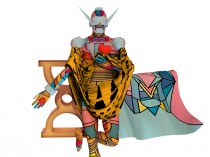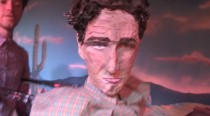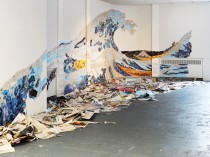This year saw a continuation of the Painting & Printmaking and the Photography departments’ inclinations towards cross-disciplinary and 3-D work, and perhaps the strongest examples of this trend for the past few years. Where sometimes, these have taken the form of carefully arranged installations of “chaos” that absurdly insist on frontal orientation and feel contrived, this year steered clear of ostentation and showed persuasive, sophisticated uses of mixed media, most notably among the Photographers.
Lale Arikoglu’s installation combined found images and footage with her own photographs; framed work with loose sheets and Post-its; tiny, meticulous ink drawings of natural forms with handwritten and printed matter; and elements that could have been works in their own right with ones that, removed from the installation, might simply have been research. Modes of doubling, recurrence of subjects and materials, and cross-referencing across the body of works tied them all together with a delicate balance that commanded the viewer’s scrutiny a second time, in a manner reminiscent of the Icelandic conceptual artist Hreinn Fridfinnsson.
In a similar vein, Lisa-Marie Reynolds’ work on negative body image combined drawings, ceramic body casts, and other text works in a skilful, coherent way that allowed her to incorporate very slight, lo-fi pieces without them paling into insignificance, such as a wall-mounted, finger-sized piece of glass with a crack in it, bearing the label ‘No fingertips.’
Another photographer, Thomas Horák, ventured further into the 3-D realm, with a great assortment of objects including motorised ferrets, end-to-end pint glasses containing confetti, bunches of nails soldered together, a film playing on a TV monitor, and an electric motor which provided a constant hum. With an almost too numerous and wide-ranging collection of scientific and domestic items, and small motorised furry things flying around, it had the feel of an interactive science museum, but without the interactive element. Inspection of the list of titles proved enlightening, but also limited some of the works to one-liners.
Horák did, however, negotiate his awkward corner space by leaving a circle of the floor unpainted and arranging his works around it. As ever, appraising the show meant having one’s judgement coloured by how well the artists had managed the lack of space, before one even began to assess the work.
This being so, one might expect the large-scale sculptures to be at a particular disadvantage, and indeed they were. Susanna Olczak, Naomi Bell, and Tim Pulleyn were three who showed impressive execution and attention to finish in their formalist structures, but clearly could have benefited from a little extra space. In the Mackintosh Gallery, Bell’s sleek black lines referenced the architecture of the building, and also literally reflected it in the Perspex sheets on the floor; thus, although the viewer may not have been able to step back to apprehend the piece fully, her mental image was filled in by peering directly over the base to see the reflection of wooden beams looming overhead.
Lyndsey Wardrop’s wall intervention showed a lovely, sensitive engagement with the fabric of the building: blue-grey metal slats had been inserted into the wall like an oversized air vent, and the crumbling, imperfect texture of the surround resonated with that of, well, the artschool.
As with the sculpture, the most interesting of the Painting and Printmaking works had gone for big and bold, and were a welcome antidote to the dense, involved, studies of gothic subjects that seem to be recycled year after year. Shaun O’Donnell’s twisted, fleshy humanoid lumps stood out vividly against surreal, brightly coloured wastelands, although some of the most interesting of these, depicting the fleshy forms interfacing with foreign objects, were stacked to one side on the floor. Solveig Settemsdal’s works similarly stood out for their bold, luscious, impressionistic style.
In a different strain entirely, Tilde Engstrøm’s brilliant existentialist portraits of faintly absurd characters seemed at first glance to belong in the realm of witty caricatures in a Sunday paper supplement. In fact, they covered conceptual as well as aesthetic bases, the texts and quotes accompanying the drawings designed to manipulate a predictable response in the viewers, and to purposefully distance them from the subjects so they remain “consciously critical observers.”
Two works that rendered this impossible were Paul McDonald’s affecting but humorous exploration of living with disabilities associated with thalidomide, and Gitte Hansen’s absorbing photographs, which deservedly won the Alice Duncan prize. After watching Hansen’s film of two young goats head butting each other for longer than I care to admit, I concluded that the better new work by this year’s graduates was definitely to be found among the Photography department.
The Degree Show runs from 12 – 19 June 2010.














Comments